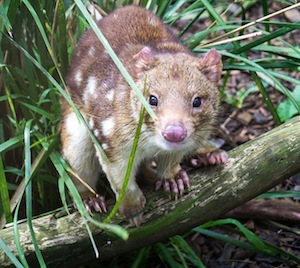Quolls live in forests in Australia.
They eat small animals as well as some plants.
Their fur is brown with white spots.
When the female has babies they stay in her pouch.
A quoll's pouch is made by folds of skin on her stomach.
©Getty Images
On his voyage of discovery to Australia, Captain Cook recorded 'quoll' as their Aboriginal name.
When settlers came to Australia, they gave them names similar to European animals, such as 'native cat' or 'native marten'.
What is a quoll?
The quoll is a small marsupial. There are four different species, or kinds, of quoll.
Habitat and Distribution (where they are found)
Eastern quoll. ©Getty Images
Quolls live in isolated forest areas in Australia.
Quolls were once found throughout the continent, but now the different species are each found in different parts of Australia:
The spotted-tailed quoll, the largest, is found along the east coast of Australia. Also called tiger quoll.
The western quoll is found only in a small area in the southwest of Western Australia. It is also known as chuditch in the language of the Nyoongar people.
The eastern quoll is found only in Tasmania.
The northern quoll, the smallest, is found in the tropical north.
Appearance and Behaviours
Spotted tail quoll. ©Getty Images
They are between 35-75 cm long, with long tails about 40 cm long. Their bodies are reddish to dark brown with white spots. The spotted-tailed quoll is the only one with spots, which appear on the tail as well as the body.
They are lively animals, with pointed snout and sharp teeth. Quolls bound along on the ground and climb trees. They hunt mainly at night, but sometimes in the day as well.
Diet
Quolls are carnivores, meaning they eat meat. They hunt birds, small mammals, lizards and insects and any animals they find dead or carrion, which means dead animals they find. They also eat fruit. This cleans up the forest.
Spotted tail quoll. ©Getty Images
Life Cycle
After mating with a male, folds of skin on the female's belly develop into a pouch that opens towards her back legs. After 21 days, she gives birth to as many as 30 tiny, undeveloped young, but has only 6 teats so the ones that cannot attach themselves to a teat will die. The surviving young remain attached to a teat for about 8 weeks, then are carried on their mother's back and fed in a nest for 6 weeks.
Conservation Status and Threats
Quolls are endangered.The number of quolls is decreasing through habitat loss and predation by foxes and feral cats.
Read and watch a video about conservation programs to save quolls:
A northern quoll in the Daintree rainforest, Queensland. ©Getty
Read about quolls and watch a video of the eastern quoll:
https://www.activewild.com/quoll-facts-for-kids/






